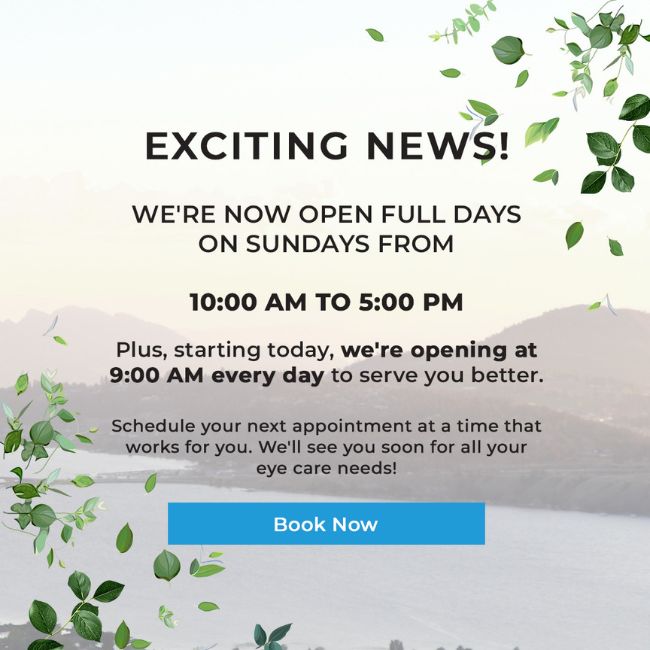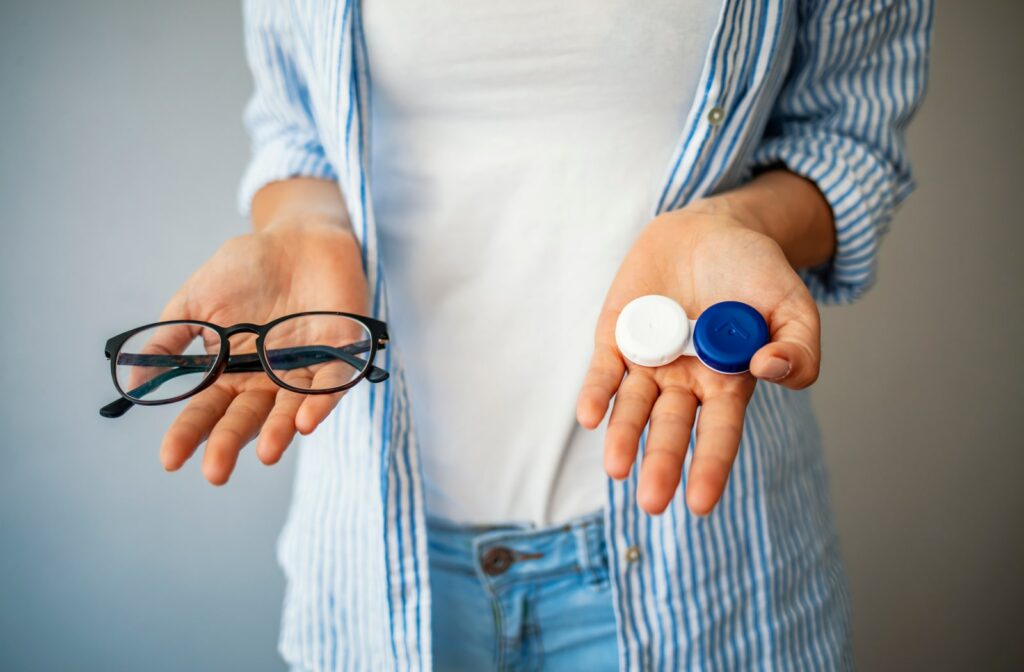Your eyes are complex structures. The muscles, membranes, and tissue are essential to maintaining healthy, effective vision. Eye exams help evaluate sight, but they’re vital to protecting your health. Yet, there’s more than one type of eye test.
When you choose to wear contact lenses, you’ll need a contact lens exam. But does a contact lens exam replace your routine eye exam? What’s the difference between an eye exam and a contact lens exam?
Sight Test vs. Comprehensive Eye Exam
There are 2 main types of eye exams. A comprehensive eye exam assesses eye health and vision, while a sight test is more limited in scope. It’s similar to a routine physical with your family doctor versus a doctor’s appointment to discuss a specific health issue.
In both types of eye exams, your optometrist will assess your eyes. However, eye exams evaluate the visual system to help prevent and treat eye diseases and conditions.
Children’s eye exams can assess the development of visual abilities and provide recommendations when necessary. Early detection can stop vision problems from interfering with visual development, school performance, and issues with life-long vision.
Adult eye exams shift from visual development to achieving comfortable, healthy vision. Optometrists use eye exams to learn about a patient’s eye health and vision, including:
- Analysis of a patient’s vision needs at home, work, or leisure
- Assessment of prescription or refractive status (focusing power)
- Binocular vision assessment (eye coordination, depth perception, eye movements)
- Diagnosis of eye health (inner and outer tissue)
- Discussion of family history (eye health and medical issues)
- Evaluation of colour vision
- Measurement of visual acuity in each eye (separately & together)
- Neurological assessment of the visual system
- Peripheral (side) vision testing
- Screening for glaucoma (including eye pressure testing)
Additional testing and examinations may be included, depending on previous eye exams or the patient’s vision needs. For example, a diabetic eye exam considers issues related to diabetes and how they affect eye health, such as diabetic retinopathy.
Another example is tailoring the eye exam for contact lens wearers. Patients who wear contact lenses long-term are more prone to issues affecting the ocular surface, including:
- Allergic reaction to contact lens solution
- Burning or itchy eyes
- Corneal ulcers or scarring
- Changes to cornea shape
- Decreased oxygen flow (hypoxia)
- Deposits on lenses
- Dry eye (or excessive eye-watering)
- Eye infections, including conjunctivitis (pink eye)
- Eye or eyelid swelling
The eye exam will still evaluate inner and outer eye tissue but may include additional testing for the ocular surface. The discussion about the patient’s vision needs will extend to how they feel about their contact lenses and how wear affects their eye health.
What to Expect at a Contact Lens Exam
Unsurprisingly, the primary purpose of a contact lens exam is to evaluate your eyes for contact lenses. But your optometrist will still assess if contact lenses are a healthy choice for your eyes. For example, your optometrist may evaluate your tear film. Your eyes need to produce enough quality tears to prevent dry eye.
Prescription Evaluation
Diagnosing your prescription is part of a contact lens exam, even if you have an up-to-date eyeglasses prescription. An eyeglasses prescription uses lenses positioned 12 mm away from the eyes. Yet, a contact lens sits directly on the eye surface. The difference in the distance changes the prescription.
Eye Measurements
Measuring the eye means fitting it to your unique eye shape. Your eye doctor will use various instruments to measure the size and shape of your eyes, including the cornea, pupil, and eye curvature. A proper fit prevents your contact lens from slipping and improves how effectively they correct vision.
Your eye doctor may use a keratometer or a corneal topographer to analyze the shape of your eye and cornea. Knowing the shape is crucial for how the contact lens will sit on your eye surface and the accuracy of your prescription. Measuring the pupil size also helps ensure your lens is positioned correctly.
Trial & Adaption
Receiving your first pair of contact lenses isn’t necessarily the end of your fitting. Your optometrist will send you home with a trial pair. The temporary pair lets you test out your lenses while your permanent lenses are prepared.
Contact lenses require a breaking-in period, much like buying a new pair of shoes. Most rigid gas permeable RGP) contact lenses take 2–4 weeks to break in. The patient wears the lenses for increasingly longer periods each day. Soft contact lenses usually have a short adaption period.
The trial pair and adaption period are chances for the patient to learn about their wear style. For example, they may switch to soft contacts because they prefer less frequent wear, or they may want to try RGP contacts for sharper vision. Additionally, the patient may benefit from daily disposable rather than a weekly replacement schedule if the patient has dry eyes.
Follow-up Exam
A follow-up exam assesses the patient’s comfort and eye health after wearing their lenses for a short period. Your optometrist will also check the fit and alignment of the contact lens.
The follow-up is not a comprehensive eye exam. Instead, it focuses on cornea health and eye structures related to lens wear.
Book the Right Exam for Your Eyes
Routine eye exams and contact lens exams are equally crucial for maintaining eye health. Although a contact lens exam will evaluate the health of your eye, a comprehensive exam is a more thorough evaluation.
Our team strives to create a caring environment providing high-quality eye care for patients and families. Visit Orchard Park Optometry in Kelowna for routine eye exams or contact lens exams.





